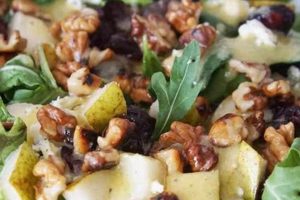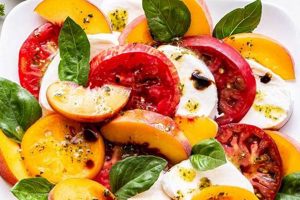This layered dessert features a pretzel crust, a creamy, often cream cheese-based middle layer, and a topping of glazed strawberries. Variations exist, including the use of different cheeses, the addition of other fruits, and adjustments to the sweetness levels of each component. An example might include a crust made from crushed pretzels and butter, a filling incorporating cream cheese, whipped cream, and sugar, and a topping of sliced strawberries cooked with sugar and cornstarch to create a glaze.
The combination of salty, sweet, and tart flavors contributes to this dessert’s broad appeal. The contrasting texturescrunchy, creamy, and smoothfurther enhance its enjoyment. Its relative ease of preparation and customizable nature have made it a popular choice for potlucks, picnics, and family gatherings for generations, particularly in the Southern United States. Its origins are often traced back to community cookbooks and shared recipes, reflecting a tradition of home-baked, crowd-pleasing desserts.
The following sections will explore the history and origins of this layered dessert, provide detailed instructions for creating it, and offer variations for customization.
Tips for a Perfect Layered Pretzel Dessert
Achieving optimal results with this dessert requires attention to several key factors impacting flavor, texture, and presentation. The following tips offer guidance for creating a successful and satisfying culinary experience.
Tip 1: Crust Consistency: Finely crush pretzels for a smooth crust or leave some larger pieces for added texture. A food processor simplifies the crushing process. Ensure thorough mixing with melted butter for even binding and prevent a crumbly crust.
Tip 2: Cream Cheese Quality: Use full-fat cream cheese for the best flavor and texture in the filling. Ensure the cream cheese is softened to room temperature for optimal blending and a smooth consistency.
Tip 3: Whipped Cream Stability: Use stabilized whipped cream or whip fresh cream with a stabilizer like gelatin or cornstarch to prevent the filling from becoming watery. Chill the filling thoroughly to further enhance its stability.
Tip 4: Strawberry Glaze Thickness: Adjust cornstarch levels in the strawberry topping to achieve the desired glaze consistency. A thinner glaze will provide a lighter coating, while more cornstarch creates a thicker, more substantial topping.
Tip 5: Assembly and Chilling: Allow each layer to set fully before adding the next to prevent mixing and maintain distinct layers. Chill the assembled dessert thoroughly for at least two hours before serving to allow flavors to meld and the layers to firm up.
Tip 6: Presentation Enhancements: Garnish the finished dessert with fresh strawberries, a dusting of powdered sugar, or a drizzle of melted chocolate for an enhanced visual appeal. Serve chilled on individual plates or as a larger centerpiece dessert.
Tip 7: Ingredient Adaptability: This dessert welcomes variations. Different fruits, such as raspberries or blueberries, can be substituted for strawberries. Alternative crust options include graham crackers or shortbread cookies. Flavor extracts like vanilla or almond can be incorporated into the cream cheese layer.
By following these guidelines, one can create a delectable and visually appealing layered dessert. The attention to detail will ensure a delightful balance of flavors and textures, leaving a lasting impression.
The next section will explore commonly encountered challenges in preparing this dessert and offer solutions for overcoming them.
1. Pretzel Crust
The pretzel crust forms the foundational layer of this dessert, providing a textural and flavor counterpoint to the sweeter components. Its salty, buttery crunch offers a necessary contrast to the creamy filling and tart strawberry topping. This interplay of contrasting elements is crucial for the overall balance and appeal of the dish. Without the pretzel crust, the dessert would lack the textural complexity and salty dimension that define its character. For instance, imagine a version made solely with a graham cracker crust; the flavor profile would shift dramatically, losing the unique salty-sweet dynamic.
The pretzel crust also contributes structural integrity to the dessert. Its firm base supports the weight of the cream cheese layer and the strawberry topping, preventing the dessert from collapsing. The butter used to bind the crushed pretzels acts as a cohesive agent, ensuring the crust holds its shape. This structural role is essential for both the presentation and the ease of serving. Consider a scenario where the crust is too crumbly; slicing and serving neat portions would become challenging.
In summary, the pretzel crust plays a vital role in the overall success of the dessert. It provides not only a textural and flavor contrast but also crucial structural support. Understanding the importance of this component allows for informed choices regarding pretzel selection, crushing techniques, and butter ratios, ultimately contributing to a more satisfying and successful culinary outcome. Neglecting the crust’s significance can compromise the dessert’s signature balance of flavors and textures.
2. Creamy Filling
The creamy filling serves as a crucial bridge between the salty pretzel crust and the tart strawberry topping in this layered dessert. Its primary function is to provide a textural and flavor contrast, mediating between the crunchy base and the fruit layer. The filling’s smooth, rich consistency offers a welcome contrast to the crust’s texture, while its sweetness balances the tartness of the strawberries. This interplay of contrasting elementssalty, sweet, and tartis essential for the dessert’s overall appeal. For example, a filling made with tangy cream cheese complements the sweetness of the strawberries and the saltiness of the pretzels, creating a harmonious flavor profile. Removing the creamy filling would result in a disjointed experience, lacking the smooth transition between the contrasting layers.
The composition of the creamy filling influences the overall sweetness and richness of the dessert. Commonly, cream cheese, whipped cream, and sugar form the base of this layer. Variations may incorporate additional ingredients like vanilla extract or other flavorings to enhance the complexity. The proportion of each ingredient affects the final taste and texture; for instance, increasing the sugar content results in a sweeter filling, while adding more whipped cream creates a lighter, airier texture. Understanding these relationships allows for customization based on individual preferences. Consider a variation where mascarpone cheese replaces cream cheese; the resulting filling offers a richer, tangier flavor profile, altering the dessert’s overall character.
In conclusion, the creamy filling is not merely a component but a defining element of this dessert. Its textural contrast, flavor balancing role, and customizable nature contribute significantly to the overall sensory experience. A well-executed filling harmonizes the other components, resulting in a cohesive and satisfying dessert. Challenges can arise if the filling is too sweet, too dense, or lacks flavor complexity. Addressing these challenges requires careful consideration of ingredient proportions, flavor pairings, and techniques for achieving the desired texture. The creamy filling, therefore, represents a critical point of consideration in achieving a successful and balanced dessert outcome.
3. Strawberry Topping
The strawberry topping represents the final layer and a defining characteristic of this dessert. It provides a crucial balance of sweetness and tartness, complementing the salty pretzel base and the rich, creamy middle layer. This topping is not merely an addition but an integral component that contributes significantly to the overall flavor profile and visual appeal.
- Flavor Profile
The topping’s flavor profile hinges on the balance between the natural sweetness of ripe strawberries and a contrasting tartness. This balance is often achieved through the addition of sugar and an acidic element, such as lemon juice, during the cooking process. This sweet-tart combination provides a refreshing counterpoint to the richness of the underlying layers. For instance, a topping made with overly sweet strawberries might overwhelm the other flavors, while insufficient tartness could result in a bland or one-dimensional taste experience.
- Texture and Consistency
The texture of the strawberry topping ranges from a chunky sauce with distinct strawberry pieces to a smoother, glaze-like consistency. The desired texture influences ingredient choices and cooking methods. A thicker topping might involve the use of a cornstarch slurry or a longer cooking time to reduce the strawberry mixture and create a more substantial consistency. Conversely, a thinner topping might require less cooking time or the addition of water or juice to maintain a more fluid consistency. The chosen texture contributes to the overall sensory experience of the dessert. For example, a chunky topping provides textural contrast, while a smoother glaze offers a more uniform coating.
- Visual Appeal
The vibrant red color of the strawberry topping contributes significantly to the dessert’s visual appeal. The glistening surface of a freshly made topping adds an element of attractiveness, enhancing the overall presentation. This visual element is often strategically used to create an enticing first impression. Consider the impact of a dull, unappetizing topping; it could detract from the overall enjoyment of the dessert, regardless of its flavor. The visual appeal is a crucial aspect of the dining experience.
- Freshness and Seasonality
Using fresh, ripe strawberries, particularly during their peak season, enhances the flavor and quality of the topping. The natural sweetness and vibrant aroma of in-season strawberries elevate the dessert to another level. While frozen strawberries offer convenience, they may lack the same intensity of flavor and can sometimes result in a watery topping. Opting for fresh, high-quality strawberries, when available, can significantly impact the overall taste and enjoyment.
These facets of the strawberry topping underscore its essential role in this dessert. The interplay of flavor, texture, visual appeal, and freshness contributes to a harmonious and balanced culinary experience. The topping not only completes the dessert but also elevates it from a simple combination of ingredients to a more complex and satisfying creation. Careful consideration of each aspect is essential for achieving optimal results.
4. Ingredient Proportions
Ingredient proportions play a critical role in the success of this layered dessert. The balance between the salty pretzel crust, sweet creamy filling, and tart strawberry topping defines the overall flavor profile. Careful consideration of ingredient ratios ensures a harmonious blend of contrasting tastes and textures. Understanding the interplay between these components is crucial for achieving a well-balanced and enjoyable dessert.
- Crust Component Ratio:
The ratio of crushed pretzels to melted butter dictates the crust’s texture and structural integrity. Too much butter can result in a soggy crust, while too little can lead to a crumbly, unstable base. A proper balance ensures a firm yet slightly crumbly crust capable of supporting the other layers. For example, a typical ratio might involve one and a half cups of crushed pretzels to one-third cup of melted butter. This balance provides sufficient cohesion without compromising the desired texture.
- Filling Sweetness and Tang:
The sweetness of the filling, primarily determined by the amount of sugar, must balance the tartness of the cream cheese and the anticipated tartness of the strawberry topping. Overly sweet fillings can mask the other flavors, while insufficient sweetness can result in a bland or unbalanced taste. Adjusting the sugar content based on the chosen cream cheese and the ripeness of the strawberries allows for customization and flavor optimization. Using a reduced-fat cream cheese, for example, might necessitate adjusting the sugar level to compensate for the tangier flavor.
- Strawberry Topping Consistency:
The ratio of strawberries to sugar and any thickening agents, such as cornstarch, determines the topping’s consistency and sweetness. A higher proportion of cornstarch yields a thicker glaze, while more sugar intensifies the sweetness. Balancing these elements ensures a topping that complements the other layers without being overly sweet or too thin. A thicker topping might be preferred for a more substantial texture, while a thinner topping offers a lighter, more fluid consistency.
- Overall Balance and Harmony:
The overall success of this dessert relies on the harmonious interplay of all components. Each layer contributes to the final flavor profile, and the proportions of each ingredient within those layers must be carefully considered. A well-balanced dessert features a noticeable contrast between the salty crust, sweet filling, and tart topping, without any single element overpowering the others. Achieving this balance requires careful attention to detail and an understanding of how each ingredient contributes to the overall taste and texture. This balance prevents the dessert from becoming overly sweet, overly salty, or lacking in textural variation.
Mastering ingredient proportions is essential for creating a successful layered pretzel dessert. A well-balanced recipe results in a harmonious blend of flavors and textures, offering a satisfying and enjoyable culinary experience. Slight adjustments to ingredient ratios allow for customization based on personal preferences and the specific ingredients used. Careful attention to these details elevates the dessert from a simple combination of components to a cohesive and well-executed culinary creation. Ignoring these proportions can lead to imbalances, such as an overly sweet filling or a soggy crust, compromising the overall quality and enjoyment of the dessert.
5. Chilling Time
Chilling time is a crucial element in the preparation of this layered dessert, significantly impacting both its structural integrity and flavor development. Sufficient chilling allows the individual layersthe pretzel crust, creamy filling, and strawberry toppingto solidify and meld, creating a cohesive and harmonious dessert. This chilling period is not merely a suggestion but a necessary step that affects the final product’s texture, flavor, and overall presentation.
The impact of chilling time is particularly evident in the stabilization of the creamy filling. This layer, often composed of cream cheese and whipped cream, benefits from refrigeration as it allows the ingredients to firm up. Without adequate chilling, the filling may remain soft and unstable, potentially leading to a collapsed or poorly defined dessert structure. A minimum chilling time of two hours is generally recommended, although longer periods, such as four hours or overnight, can further enhance the stability and allow the flavors to meld more completely. For example, a dessert chilled overnight will exhibit a firmer, more structurally sound filling compared to one chilled for only an hour.
Furthermore, chilling allows the flavors of the various components to harmonize. The salty notes of the pretzel crust, the sweetness of the creamy filling, and the tartness of the strawberry topping have time to blend and mellow, creating a more complex and balanced flavor profile. This melding of flavors is essential for the dessert’s overall appeal. Insufficient chilling can result in a disjointed flavor experience, with each layer tasting distinct and separate rather than integrated. The chilling process, therefore, contributes not only to structural integrity but also to a more nuanced and enjoyable taste experience. This understanding underscores the importance of incorporating adequate chilling time into the preparation process for optimal results.
6. Presentation
Presentation plays a significant role in the overall enjoyment of this layered dessert. While taste and texture are paramount, visual appeal enhances the dining experience, creating anticipation and adding to the perceived value of the dish. A thoughtfully presented dessert elevates it from a simple combination of ingredients to a more appealing and memorable culinary creation. Consideration of various presentation aspects, from serving dish selection to garnishing choices, contributes to a more satisfying and aesthetically pleasing experience. A well-presented dessert reflects care and attention to detail, enhancing the perception of both the dish and the preparer’s skill.
- Serving Dish Selection
The choice of serving dish significantly impacts the presentation. A clear glass dish allows for the appreciation of the distinct layers, showcasing the contrasting colors and textures. A shallow, wide dish facilitates easier serving and portioning, while a deeper dish might be suitable for larger gatherings. The dish’s shape and size should complement the dessert and the overall table setting. An ornate serving dish might be appropriate for a formal occasion, while a simpler dish suits a casual setting. For example, serving individual portions in small, stemmed glasses adds a touch of elegance, while a rustic pie plate contributes to a homestyle presentation.
- Garnishing Techniques
Garnishing adds a finishing touch, enhancing visual appeal and providing subtle flavor accents. Fresh strawberries, a dusting of powdered sugar, or a sprig of mint complement the dessert’s flavors and colors. Chocolate shavings or a drizzle of caramel sauce can add a touch of decadence. The key is to choose garnishes that enhance, not overwhelm, the dessert’s existing elements. Overly elaborate garnishes can detract from the dessert’s inherent beauty. A simple garnish of fresh mint leaves, for example, adds a touch of freshness and visual contrast without being overpowering.
- Slicing and Portioning
Neatly sliced and evenly portioned servings enhance the presentation and facilitate serving. A clean, sharp knife is essential for achieving precise cuts and maintaining the integrity of the layers. The size of the portions should be appropriate for the occasion and the overall meal structure. Uniform portioning ensures a consistent and visually appealing presentation. For instance, serving uneven or crumbly slices can detract from the dessert’s appearance, even if the taste remains unaffected.
- Contextual Considerations
The presentation should also consider the context of the serving occasion. A casual family gathering might call for a simpler, more rustic presentation, while a formal dinner party might warrant a more elegant and refined approach. The surrounding table setting, including linens, tableware, and other dishes, should complement the dessert’s presentation. A cohesive and well-considered presentation enhances the overall dining experience. Serving the dessert on mismatched plates or in a cluttered setting, for example, detracts from the overall aesthetic and can diminish the perceived value of the dish.
These elements of presentation contribute significantly to the overall enjoyment of this layered dessert. While the taste and texture remain primary considerations, visual appeal enhances the sensory experience, creating anticipation and adding a touch of elegance. A thoughtfully presented dessert elevates the dining experience, demonstrating care and attention to detail. By considering these aspects of presentation, one can transform a simple dessert into a visually stunning and memorable culinary creation. This attention to presentation ultimately enhances the perceived value and enjoyment of the dessert, demonstrating the preparer’s culinary skill and appreciation for aesthetics.
Frequently Asked Questions
This section addresses common inquiries regarding the preparation and variations of this layered dessert, offering practical solutions and clarifying potential points of confusion.
Question 1: Can the pretzel crust be made ahead of time?
Yes, the pretzel crust can be prepared a day in advance. After pressing it into the pan, cover tightly with plastic wrap and store at room temperature or in the refrigerator. This allows for more efficient time management when preparing the dessert.
Question 2: What can be used as a substitute for cream cheese in the filling?
Mascarpone cheese or a combination of Greek yogurt and whipped cream can substitute for cream cheese, altering the flavor and texture slightly. Neufchtel cheese can also serve as a lower-fat alternative.
Question 3: How can one prevent the strawberry topping from becoming too watery?
Using fresh, ripe strawberries and ensuring the glaze is cooked to the proper thickness helps prevent a watery topping. Adequate cornstarch and sufficient cooking time are crucial for achieving the correct consistency.
Question 4: Can this dessert be frozen?
While freezing is possible, the texture of the filling may change upon thawing. Freezing is generally not recommended for optimal results, as the whipped cream component may become watery. It’s best enjoyed fresh.
Question 5: What are some variations for the strawberry topping?
Other fruits, such as raspberries, blueberries, or a mixture of berries, can be substituted for strawberries. Adjusting the sugar and cornstarch levels may be necessary based on the chosen fruit’s sweetness and water content.
Question 6: How long can the assembled dessert be stored in the refrigerator?
This dessert is best consumed within two to three days of preparation. Cover tightly with plastic wrap to prevent it from drying out or absorbing odors from other foods in the refrigerator.
Understanding these common inquiries and their corresponding solutions can contribute to a more successful and enjoyable dessert-making experience. Addressing these points clarifies potential challenges and encourages experimentation with variations.
The following section will offer concluding thoughts and summarize key takeaways for preparing a perfect dessert.
Strawberry Pretzel Salad
This exploration of strawberry pretzel salad has provided a comprehensive overview of this classic dessert. From the foundational pretzel crust to the creamy filling and vibrant strawberry topping, each component’s contribution to the overall flavor profile and textural complexity has been examined. Emphasis has been placed on the importance of ingredient proportions, chilling time, and presentation techniques in achieving optimal results. The interplay of salty, sweet, and tart flavors, combined with the contrasting textures, defines this dessert’s enduring appeal. Understanding these elements allows for informed decision-making during preparation, enabling customization and ensuring a successful outcome.
Strawberry pretzel salad represents a timeless dessert, appreciated for its balance of flavors, ease of preparation, and adaptability. Its continued presence in culinary traditions underscores its enduring appeal. This exploration serves as a guide for both novice and experienced bakers, empowering culinary creativity and ensuring the successful execution of this beloved dessert. The knowledge gained here provides a foundation for crafting a delightful and memorable culinary experience, showcasing the enduring appeal of this classic dessert.






